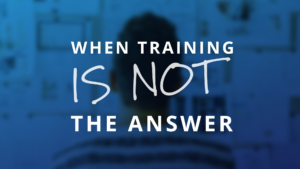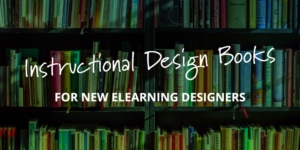
Instructional Design for eLearning: 4 Things You Need to Know
Instructional design for eLearning can be a challenge. It’s easy to slap a bunch of bullet points on a slide, tell the learner everything they need to know, add a next button, and call it eLearning. However, it’s not so easy to design an eLearning course that’s interactive, visually stunning, and focused on performance.
If you’re a new eLearning designer, your instructional design experience depends largely on your background. Although some eLearning designers enter the industry with a lot of instructional design experience, if you’re like me, you fell into the world of eLearning with zero experience.
If you’re looking to improve the effectiveness of your courses, here are four things you should know about instructional design for eLearning.
Clicking Doesn’t Always Create Meaningful Interactivity

When you’re new to eLearning, your concept of creating interactive content might be as simple as the learner clicking to reveal some learning content. However, let me ask you this: how much knowledge or critical thinking does it take for the learner to execute this task? Not much! With this type of click-to-reveal interactivity, the most the learner needs to know is how to use a mouse to click a button! In other words, the interaction isn’t meaningful.
Instructional design for eLearning isn’t just about what learning content is presented to the learner; it’s also about how the learning content is presented. Although a click-to-reveal interaction might be a good way to organize and present some content, it doesn’t encourage performance by engaging their critical thinking skills.
When designing an eLearning course, strive to create interactions that require the learner to think before clicking. Challenge your learners to make a decision or provide a response based on the knowledge provided earlier in the course.
Knowledge and Behavior Aren’t Mutually Exclusive

When I first started in eLearning, my learning content was overflowing with information! I was obsessed with covering everything I thought my learners needed to know or be aware of. I was convinced that if I pumped enough knowledge and information into the heads of my learners, it would turn into results. I was wrong.
Instructional design for eLearning isn’t about information and knowledge; it’s about behaviors and performance. It’s easy to measure how much information your learners remembered by quizzing them, but does passing a quiz mean your learners will be better at doing their jobs? I don’t think so.
The truth is, your learners don’t need to “be aware” of anything! What your learners really need is the knowledge, skills, and practice to change or emulate specific behaviors. This is important because behaviors tend to have a direct correlation to a business result and are measurable against a goal.
Before figuring out what it is your learners need to know, figure out what it is they need to do and build your eLearning around that.
eLearning Isn’t Always the Right Solution

Early in my career, I was convinced that every learning problem could be solved with an eLearning course. Even when the classroom proved to be more effective in certain situations, I was convinced I could recreate the same learner experience and effectiveness in an eLearning format. I was wrong!
I quickly learned that eLearning is just one piece of a larger ecosystem for learning. Because people learn in a variety of ways, it’s important to provide variety in your learning strategy! No single learning methodology works for everyone.
Instructional design for eLearning requires you to analyze and recommend the best way to approach a learning problem. Sometimes the solution is eLearning, and sometimes it’s an instructor-led class, a job aid, or nothing at all!
eLearning is More Than Just Instructional Design

When I designed and developed my very first eLearning course, I put all of my efforts into instructional design. Although I wanted my courses to look better and be easier to use, I only worried about those things if I had the extra time at the end of a project.
Over time, I started to recognize all of the other components that go into creating an effective eLearning course. It’s not just instructional design—it’s graphic design, user interface design, and visual communications! And I learned that these things could either help to elevate the effectiveness of my instructional design; or worse, detract from it.
When you start with bullet points in your storyboard, you’ll end up with bullet points on your slides. And, when your course isn’t easy to use, the quality of your instructional design doesn’t matter! Instructional design for eLearning isn’t just about developing great learning content; it’s about creating great learning experience.
What else should new eLearning designers know about instructional design for eLearning? Share your tips by commenting below!
Additional Resources
- Getting Started with The eLearning Development Process
- 3 Misconceptions About eLearning That Most People Get Wrong
- What Makes Good eLearning?
- Tips for Brainstorming & Designing eLearning Interactions
- How to Conduct an eLearning Needs Analysis
- 3 Ways to Design Better eLearning
- Graphic Design vs. Visual Communications for eLearning
- 4 Tips for Effective User Interface Design for eLearning




Tim,
Very informative and eye opening. As someone who is intrigued by eLearning as a educator as well as a learning, I can’t wait to dive further down the rabbit hole of Instructional Design.
The post is very nicely written and it contains many useful facts regarding Instructional design and E learning. I am happy to find your distinguished way of writing the post. Now you make it easy for me to understand and implement. Thanks for sharing with us.
Thanks for reading!
Nice and timely article— particularly for up and coming ID’s! Get the book to press so I can buy it!
Thanks, Curtis! You’ll be able to buy the book on July 17th!!! 🙂
I completely agree with you,
I see as well, that narration plays a great role of importance in representing e-content course, I had always argues with SME’s regarding how to write a narration script, and the problem always appears that sme’s always care about giving all the info regardless the quantity, while I care about how to represent the info in simply ways, or els my learner will get bored and leave the course.
Hi Tim! Great post. Tim, what software did you use to create the animation in this video at the 1:50 mark? I’d love to do something similar.
Really great post! I found it very informative and interesting. I’ll really get the great advantage from your good stuff. Keep sharing!
Hey Tim,
Great post!
You really nailed it. Even I’m never convinced with the click and reveal stuff. Learner engagement is when you challenge them with something or make them ponder over something using interactive case studies/ scenarios.
IDs should learn to differentiate between ‘need to know’ and ‘nice to know’ information.
You are absolutely right when you say elearning is much more than instructional design.
In today’s world many companies are using rapid authoring tools. Gone are the days when IDs were just involved in storyboarding using word. Now they are involved in development using authoring tools. To move with the trend , it is important for the new IDs to know how to judiciously make use of interactivities, graphics, colors, fonts etc.
Thanks for the comment, Kripa! I appreciate it! While I don’t mind click-to-reveal interaction…I think they have their place…I think it’s important that instructional designers understand when a click-to-reveal is appropriate and when it’s not.
This article is spot on Tim. I am not instructional designer or e learning developer but for several years developing content for low literacy vulnerable groups and conducting class room training.
I was reading this article in today’s context – Agree completely with you that learners learn differently and therefore variety of methodologies need to be used. But in today’s context where COVID 19 has brought in several limitations – remote learning seems to be the ideal option especially to train and scale development projects in remote locations. How does one address this problem. Any thoughts?